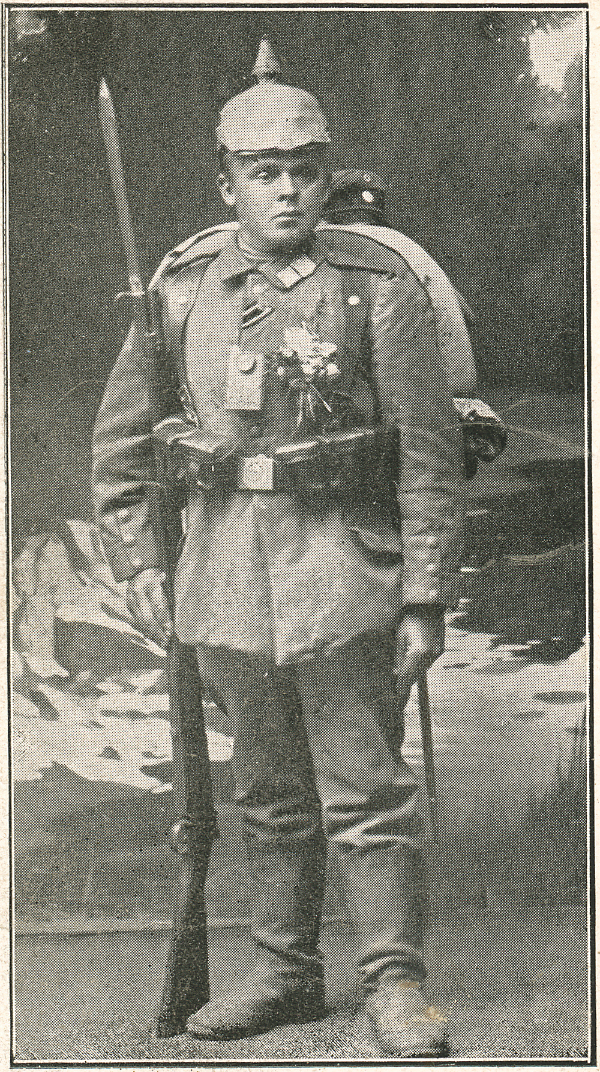Ldstm
Ferdinand Fahrner
Information about birth
|
Date of birth: 25/07/1890 |
|
Place of birth: Siegensdorf, Rottenburg, Niederbayern, Kingdom of Bavaria, German Empire |
General information
|
Last known residence: Siegensdorf, Rottenburg, Niederbayern, Kingdom of Bavaria, German Empire |
|
Profession: Farmer |
|
Religion: Roman Catholic |
Army information
|
Country: German Empire |
|
Force: Imperial German Army |
|
Rank: Landsturmmann |
|
Enlistment date: 06/11/1915 |
|
Units: — 7. Kompagnie, II. Bataillon, Kgl. Bayer. Infanterie-Regiment Nr. 16 (Last known unit) |
Information about death
|
Date of death: 23/10/1917 |
|
Place of death: Gheluvelt, Belgium |
|
Cause of death: Killed in action (K.I.A.) |
|
Age: 27 |
Cemetery
|
Deutscher Soldatenfriedhof Langemark (Kameradengrab) Plot: Unknown Row: Unknown Grave: Unknown |
Distinctions and medals 2
|
Bayer. Militair-Verdienstkreuz III. Klasse mit Schwertern Medal — 18/10/1917 |
|
Eiserne Kreuz II. Klasse Medal — 17/08/1917 |
Points of interest 3
| #1 | Place of birth | ||
| #2 | Last known residence | ||
| #3 | Place of death (approximate) |
My story
Ferdinand Fahrner, a former farmer, was born 25 juli 1890 in Siegensdorf, Rottenburg, Niederbayern, Kingdom of Bavaria, German Empire. He was the son of Anton and Maria Zierer. By 1914 Ferdinand lived in Siegensdorf, Rottenburg, Niederbayern. He was called up on November 6, 1915. Around 1917 Ferdinand served as an infanterist in the 7. Kompagnie, II. Bataillon, Kgl. Bayer. Infanterie-Regiment Nr. 16, which was part of the 20. Kgl. Bayer. Infanterie-Brigade, of the 10. Kgl. Bayer. Infanterie-Division.
On 5 October 1917 the 10. Kgl. Bayer. Infanterie-Division relieved the 17. Infanterie-Division between Geluveld and Reutel. The Kgl. Bayer. Infanterie-Regiment Nr. 16 (who went into the line on the night between 6 and 7 October 1917) took the left flank of the front, the Reserve-Infanterie-Regiment Nr. 6 the middle and Reserve-Infanterie-Regiment Nr. 8 the right flank. The three battalions of the regiment were divided into a rotational system, namely a combat (kampf) battalion at the front line, a standby (bereitschafts) battalion and a Reserve battalion. The battalions switched roll and position every couple days.
The II. Bataillon relieved the standby battalion on the 19 October and relieved the combat battalion in the night between 22nd and 23 October. On the 23rd of October began calm. In the afternoon an artillery barrage commenced, shelling amongst others the headquarters near the ruins of Geluveld Chateau. This ended at 6 p.m. but at about 9 p.m. a new barrage commenced, causing casualties.
Ferdinand Fahrner, aged 27, was killed in action 23 October 1917. The kriegsstammrolle notes that he was killed at about 10:30 p.m. near Geluveld. He was buried in the grounds of Geluveld Chateau. His remains were exhumed and interred in the Kameradengrab at the Deutscher Soldatenfriedhof Langemark.
On 5 October 1917 the 10. Kgl. Bayer. Infanterie-Division relieved the 17. Infanterie-Division between Geluveld and Reutel. The Kgl. Bayer. Infanterie-Regiment Nr. 16 (who went into the line on the night between 6 and 7 October 1917) took the left flank of the front, the Reserve-Infanterie-Regiment Nr. 6 the middle and Reserve-Infanterie-Regiment Nr. 8 the right flank. The three battalions of the regiment were divided into a rotational system, namely a combat (kampf) battalion at the front line, a standby (bereitschafts) battalion and a Reserve battalion. The battalions switched roll and position every couple days.
The II. Bataillon relieved the standby battalion on the 19 October and relieved the combat battalion in the night between 22nd and 23 October. On the 23rd of October began calm. In the afternoon an artillery barrage commenced, shelling amongst others the headquarters near the ruins of Geluveld Chateau. This ended at 6 p.m. but at about 9 p.m. a new barrage commenced, causing casualties.
Ferdinand Fahrner, aged 27, was killed in action 23 October 1917. The kriegsstammrolle notes that he was killed at about 10:30 p.m. near Geluveld. He was buried in the grounds of Geluveld Chateau. His remains were exhumed and interred in the Kameradengrab at the Deutscher Soldatenfriedhof Langemark.
Sources 2
|
Brennfleck, Josef Karl. Das Königlich Bayerische 16. Infanterie-Regiment Großherzog Ferdinand von Toskana im Weltkrieg 1914-1918 (München: Verlag der Veröffentlichung des Bayerischen Kriegsarchivs, 1931), 279-292. Sources used |
|
Kriegsstammrollen, 1914-1918. (Bayerisches Staatsarchiv, München (HStA), Abteilung IV, Kriegsarchiv). https://www.gda.bayern.de/die-staatlichen-archive-bayerns/ Sources used |
More information 2
|
Namenlijst (In Flanders Fields Museum) https://namenlijst.org/publicsearch/#/person/_id=823ba62d-5ed7-4513-9295-9c8233719c59 |
|
Volksbund Deutsche Kriegsgräberfürsorge https://www.volksbund.de/erinnern-gedenken/graebersuche-online/detail/263c10fbc16518c685dad09deff41904 |
